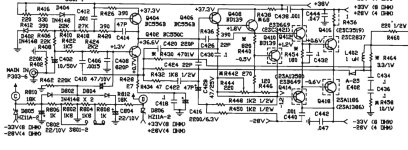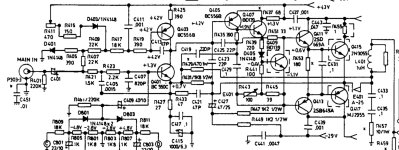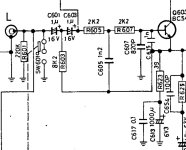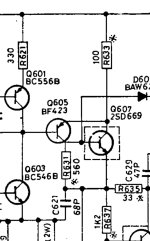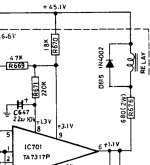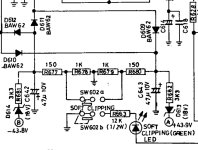NAD 3020
The NAD 3020 amplifier, introduced in 1978 by New Acoustic Dimension (NAD), is a landmark in hi-fi audio history. Designed by Bjørn Erik Edvardsen, the NAD 3020 was a game-changer, challenging the notion that high-quality sound required a significant financial investment. At the time, the audio market was dominated by expensive, high-powered amplifiers. The NAD 3020, with its modest price and minimalist design, revolutionized the landscape by offering exceptional sound quality to a broader audience.
The NAD 3020 quickly gained a reputation for its remarkable performance. Despite its modest power rating of 20 watts per channel, it delivered much higher dynamic headroom, allowing it to handle musical peaks with impressive clarity and power. This capability enabled the amplifier to compete with higher-powered models, providing an audio experience that defied its wattage. Another key feature was its high current capability, crucial for driving difficult speaker loads and controlling speaker cones with precision. This resulted in detailed and accurate sound reproduction, making the NAD 3020 suitable for a wide range of speakers and musical genres.
A significant draw for vinyl enthusiasts was the integrated high-quality phono stage, which allowed turntables to be connected directly to the amplifier, offering a warm and rich analog sound without the need for an external phono preamp. The design simplicity of the NAD 3020, both externally and internally, contributed to its superior performance. By keeping the signal path clean and using high-quality components where it mattered most, NAD ensured the amplifier could deliver pure and uncolored sound, enhancing its reliability and longevity.
The most celebrated aspect of the NAD 3020's sound was its musicality and warmth. Renowned for its ability to reproduce music with a sense of rhythm and timing, it made listening enjoyable and engaging. Its warm sound signature added richness to the audio, making it a favorite among audiophiles and casual listeners alike. The NAD 3020 remains an iconic piece of audio equipment, revered for its groundbreaking approach to sound quality and affordability. Its unique blend of power, high current capability, and musical warmth set it apart from other amplifiers of its time, contributing to its legendary status. Decades after its introduction, the NAD 3020 continues to inspire and influence modern amplifier design, cementing its place in the annals of hi-fi history.
NAD 2150
The NAD 2150 amplifier, introduced in the early 1980s, is part of NAD's legacy of producing high-quality, affordable audio equipment. It employs the same foundational design concepts that made the NAD 3020 a legend in the audio world. Both amplifiers feature a singleton input stage with a constant current source, which ensures stable and low-noise operation. Next stage - VAS (voltage amplification stage) is using complimentary feedback transistor pair, which enhances linearity and reduces distortion, allowing for a more accurate and musical sound reproduction. And finally, both models utilize an emitter follower class AB output stage, providing a balanced mix of efficiency and sound quality.
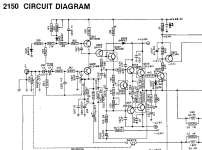
However, a significant enhancement in the NAD 2150 is its use of higher current capability output transistors. These transistors enable the 2150 to drive more demanding speaker loads with greater control and robustness, resulting in improved performance, especially with contemporary, power-hungry speakers.
Another notable difference between the NAD 2150 and its predecessor is the absence of the preamp section in the 2150. While the NAD 3020 included a preamp, making it a versatile all-in-one solution, the 2150's omission of this section makes it particularly well-suited for modern audio setups. This design choice allows users to feed the signal directly from modern DACs and other high-quality sources without the additional signal path introduced by an integrated preamp. As a result, the NAD 2150 can offer a purer and more direct signal, aligning perfectly with the preferences of today's audiophiles who often favor streamlined, minimalistic systems for the highest fidelity audio reproduction.
Singelton input stage
The singleton input stage, as utilized in amplifiers like the NAD 3020, offers distinct advantages that contribute to its enduring appeal in audio design. Unlike the differential pair, which typically involves two transistors, the singleton input stage simplifies the circuitry. This simplicity often results in lower overall noise and distortion levels, crucial for preserving the fidelity of audio signals. Additionally, the singleton configuration can offer better phase accuracy and transient response, allowing for a more accurate portrayal of the original audio waveform. These characteristics make the singleton input stage particularly well-suited for applications where high-fidelity reproduction and transparency are paramount.
However, it's essential to acknowledge that the singleton input stage has drawbacks compared to the differential pair. One notable limitation is its typically lower common-mode rejection ratio (CMRR) compared to differential configurations. This means it may be more susceptible to common-mode noise and interference, potentially impacting signal quality in environments with electrical noise. Additionally, the thermal stability and matching characteristics of the singleton input stage may not be as robust as those of differential pairs, which can affect performance consistency over varying operating conditions.
Despite these considerations, the NAD 3020 amplifier's historical success and revered sound quality stand as testament to the effectiveness of the singleton input stage when implemented with careful design considerations. The 3020's ability to deliver clean, natural sound with minimal coloration has solidified its place in audio history and continues to influence modern amplifier designs. Its enduring popularity underscores the viability and effectiveness of the singleton input stage in achieving high-quality audio reproduction, showcasing its strengths in the context of critical listening environments and audiophile preferences.
My story
After immersing myself in the rich history and technical details of vintage hi-fi equipment, particularly the NAD 3020 and its successor, the NAD 2150, I decided to delve deeper into this world by acquiring a NAD 2150 amplifier.
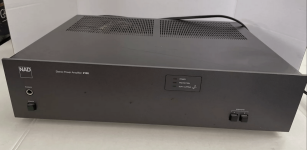
Intrigued by its renowned design principles I sought to explore its inner workings further. I obtained the service manual, complete with schematics, and delved into understanding how these components interact to produce the amplifier's distinctive sound.
Driven by curiosity and a passion for electronics, I took my exploration a step further by simulating the NAD 2150's circuit layout using LTSpice, a circuit simulation software. This exercise not only deepened my understanding of amplifier design but also allowed me to visualize how different components contribute to its overall performance. Sketching the circuit in LTSpice was both educational and enjoyable, providing insights into the amplifier's behavior under various conditions.
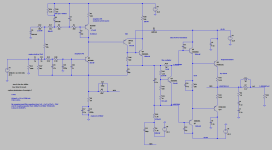
For those brave enough to open the amp and solder a few capacitors a significant improvement can be made by swapping input filter capacitors to 22uF + 22uF and DC coupling capacitor to 4700uF resulting in 0.002% THD@1kHz.
The NAD 3020 amplifier, introduced in 1978 by New Acoustic Dimension (NAD), is a landmark in hi-fi audio history. Designed by Bjørn Erik Edvardsen, the NAD 3020 was a game-changer, challenging the notion that high-quality sound required a significant financial investment. At the time, the audio market was dominated by expensive, high-powered amplifiers. The NAD 3020, with its modest price and minimalist design, revolutionized the landscape by offering exceptional sound quality to a broader audience.
The NAD 3020 quickly gained a reputation for its remarkable performance. Despite its modest power rating of 20 watts per channel, it delivered much higher dynamic headroom, allowing it to handle musical peaks with impressive clarity and power. This capability enabled the amplifier to compete with higher-powered models, providing an audio experience that defied its wattage. Another key feature was its high current capability, crucial for driving difficult speaker loads and controlling speaker cones with precision. This resulted in detailed and accurate sound reproduction, making the NAD 3020 suitable for a wide range of speakers and musical genres.
A significant draw for vinyl enthusiasts was the integrated high-quality phono stage, which allowed turntables to be connected directly to the amplifier, offering a warm and rich analog sound without the need for an external phono preamp. The design simplicity of the NAD 3020, both externally and internally, contributed to its superior performance. By keeping the signal path clean and using high-quality components where it mattered most, NAD ensured the amplifier could deliver pure and uncolored sound, enhancing its reliability and longevity.
The most celebrated aspect of the NAD 3020's sound was its musicality and warmth. Renowned for its ability to reproduce music with a sense of rhythm and timing, it made listening enjoyable and engaging. Its warm sound signature added richness to the audio, making it a favorite among audiophiles and casual listeners alike. The NAD 3020 remains an iconic piece of audio equipment, revered for its groundbreaking approach to sound quality and affordability. Its unique blend of power, high current capability, and musical warmth set it apart from other amplifiers of its time, contributing to its legendary status. Decades after its introduction, the NAD 3020 continues to inspire and influence modern amplifier design, cementing its place in the annals of hi-fi history.
NAD 2150
The NAD 2150 amplifier, introduced in the early 1980s, is part of NAD's legacy of producing high-quality, affordable audio equipment. It employs the same foundational design concepts that made the NAD 3020 a legend in the audio world. Both amplifiers feature a singleton input stage with a constant current source, which ensures stable and low-noise operation. Next stage - VAS (voltage amplification stage) is using complimentary feedback transistor pair, which enhances linearity and reduces distortion, allowing for a more accurate and musical sound reproduction. And finally, both models utilize an emitter follower class AB output stage, providing a balanced mix of efficiency and sound quality.

However, a significant enhancement in the NAD 2150 is its use of higher current capability output transistors. These transistors enable the 2150 to drive more demanding speaker loads with greater control and robustness, resulting in improved performance, especially with contemporary, power-hungry speakers.
Another notable difference between the NAD 2150 and its predecessor is the absence of the preamp section in the 2150. While the NAD 3020 included a preamp, making it a versatile all-in-one solution, the 2150's omission of this section makes it particularly well-suited for modern audio setups. This design choice allows users to feed the signal directly from modern DACs and other high-quality sources without the additional signal path introduced by an integrated preamp. As a result, the NAD 2150 can offer a purer and more direct signal, aligning perfectly with the preferences of today's audiophiles who often favor streamlined, minimalistic systems for the highest fidelity audio reproduction.
Singelton input stage
The singleton input stage, as utilized in amplifiers like the NAD 3020, offers distinct advantages that contribute to its enduring appeal in audio design. Unlike the differential pair, which typically involves two transistors, the singleton input stage simplifies the circuitry. This simplicity often results in lower overall noise and distortion levels, crucial for preserving the fidelity of audio signals. Additionally, the singleton configuration can offer better phase accuracy and transient response, allowing for a more accurate portrayal of the original audio waveform. These characteristics make the singleton input stage particularly well-suited for applications where high-fidelity reproduction and transparency are paramount.
However, it's essential to acknowledge that the singleton input stage has drawbacks compared to the differential pair. One notable limitation is its typically lower common-mode rejection ratio (CMRR) compared to differential configurations. This means it may be more susceptible to common-mode noise and interference, potentially impacting signal quality in environments with electrical noise. Additionally, the thermal stability and matching characteristics of the singleton input stage may not be as robust as those of differential pairs, which can affect performance consistency over varying operating conditions.
Despite these considerations, the NAD 3020 amplifier's historical success and revered sound quality stand as testament to the effectiveness of the singleton input stage when implemented with careful design considerations. The 3020's ability to deliver clean, natural sound with minimal coloration has solidified its place in audio history and continues to influence modern amplifier designs. Its enduring popularity underscores the viability and effectiveness of the singleton input stage in achieving high-quality audio reproduction, showcasing its strengths in the context of critical listening environments and audiophile preferences.
My story
After immersing myself in the rich history and technical details of vintage hi-fi equipment, particularly the NAD 3020 and its successor, the NAD 2150, I decided to delve deeper into this world by acquiring a NAD 2150 amplifier.

Intrigued by its renowned design principles I sought to explore its inner workings further. I obtained the service manual, complete with schematics, and delved into understanding how these components interact to produce the amplifier's distinctive sound.
Driven by curiosity and a passion for electronics, I took my exploration a step further by simulating the NAD 2150's circuit layout using LTSpice, a circuit simulation software. This exercise not only deepened my understanding of amplifier design but also allowed me to visualize how different components contribute to its overall performance. Sketching the circuit in LTSpice was both educational and enjoyable, providing insights into the amplifier's behavior under various conditions.

For those brave enough to open the amp and solder a few capacitors a significant improvement can be made by swapping input filter capacitors to 22uF + 22uF and DC coupling capacitor to 4700uF resulting in 0.002% THD@1kHz.
Attachments
Last edited:
The 2150 is a power amp, the 3020 is an integrated amp. A more equitable comparison would be between the 3020 and the integrated version of the 2150 - the 3150 - an amplifier I auditioned in 1983 in combination with Mordaunt Short MS20 speakers. Ah! Around the same time I heard the 3020 in combination with B&W DM110 speakers.Another notable difference between the NAD 2150 and its predecessor is the absence of the preamp section in the 2150.
The 3020 is certainly a legend, but should not be clouded by nostalgia - to quote its Wikipedia page - it sounded better than a $200 amplifier had a right to sound!
The 3150 (and presumably the 2150) is a distinctly better sounding amplifier. And so it should - its list price was more than twice that of the 3020.
Because NAD 3020 and 302 are almost identical in terms of circuitry - for the practical translation should be sufficient experience:
a few simple practical! improvements:
https://www.diyaudio.com/community/...ing-the-220-volt-version.368883/#post-7734043
a few simple practical! improvements:
https://www.diyaudio.com/community/...ing-the-220-volt-version.368883/#post-7734043
These circuits imply real sound degraders and preventers! I have just now carried out a quick practical test: I removed these and listened. But more on that later. My conclusion: These circuits and devices were not designed and built by developers with audio experience!
Are you talking about removing preamp section from the signal path?
Those schematics are classic three stages topologies simplified as much as it can be to remove unnecessary active devices from the signal path.
There is a theory out there that best sounding amplifier is the one with Open Loop Gain higher than 60dB at 20kHz. Meaning all frequencies below will have 60+ OLG. I tend to believe it since high OLG means good linearity region for given transistors. First watt as it is called sometimes. Except the difference is in one case negative feedback applied and in another it is not.
Those schematics are classic three stages topologies simplified as much as it can be to remove unnecessary active devices from the signal path.
There is a theory out there that best sounding amplifier is the one with Open Loop Gain higher than 60dB at 20kHz. Meaning all frequencies below will have 60+ OLG. I tend to believe it since high OLG means good linearity region for given transistors. First watt as it is called sometimes. Except the difference is in one case negative feedback applied and in another it is not.
I am referring to the power amp. This also has a completely sufficient voltage amplification, "preamp"-) But this power amplifier has some shortcomings in terms of sound and audio. But more on that later. And probably in more detail in the neighboring thread:
https://www.diyaudio.com/community/...ing-the-220-volt-version.368883/#post-7734043
Whether a general > 60 dB gain corresponds to a good sound, I do not know;-)
https://www.diyaudio.com/community/...ing-the-220-volt-version.368883/#post-7734043
Whether a general > 60 dB gain corresponds to a good sound, I do not know;-)
From the LTSpice simulation posted earlier, the NAD 2150 amplifier can be improved in several stages depending on how involved one is willing to be. The first and most straightforward upgrade would be to enhance the input filter and feedback capacitors. This can be accomplished by replacing the two 1µF capacitors C601, C603 (C602, C604) with two 22µF electrolytic capacitors, preferably of the non-polar type, and replacing the 1000µF capacitor C613/C614 with a 4700µF one. These changes will extend the low-frequency bandwidth down to 4Hz at -0.1dB and reduce Total Harmonic Distortion (THD) to 0.002% at 1kHz.
Noise performance can also be significantly improved. The input filter contains two 2.2kΩ resistors R605, R607 (R606, R608), which are the main contributors to noise. Reducing these resistors to 1kΩ improves the noise performance from 18 to 11 nV/√Hz. However, if these resistors are replaced, the filter capacitors must also be changed to avoid a high-frequency spike. All three capacitors C605, C607, and C615 should be 470pF to ensure a smooth high-frequency roll-off.
The Voltage Amplification Stage (VAS) offers several areas for enhancement. First, the Miller compensation capacitor can be reduced from 68pF to 10pF. It’s noteworthy that this capacitor was increased to 68pF in the 2150 model but was 22pF in the earlier release of the 3020 model. This adjustment improves the mid-frequency response. Additionally, the degeneration resistor can be decreased from 100Ω to 33Ω, and the 560Ω resistor can be increased to 1kΩ.
High open-loop gain in an amplifier is crucial for achieving better sound quality, characterized by a more palpable and musical wide soundstage. This is because a high open-loop gain significantly reduces distortion and enhances the linearity of the amplifier's response. When the open-loop gain is high, the feedback mechanism can effectively correct any deviations from the input signal, ensuring that the output signal closely matches the original. This results in clearer, more accurate reproduction of the audio signal, which translates to better separation and detail in the soundstage. As a result, instruments and vocals are more distinctly positioned and lifelike, contributing to a more immersive and enjoyable listening experience. All of the above changes contribute to an open-loop gain of 56dB at 20kHz and up to 90dB at 100Hz, further enhancing the amplifier's ability to deliver superior sound quality.
In the original schematic, the VAS current is set quite high at 16mA, resulting in 700mW of heat dissipation in the VAS transistor and 400mW per each bootstrap resistor. This current is set by a bootstrap network consisting of 1.2kΩ and 1.5kΩ resistors and a 47µF capacitor. Reducing the VAS current to 7mA can be safely achieved by changing both resistors to 3.3kΩ. Replacing the capacitor with a 100µF one will open up the low-frequency response down to around 4Hz.
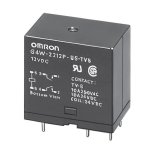
The speaker protection relay can be upgraded to an Omron G4W-2212P-US-TV5-HP-DC24, which is rated at 24V or 33mA and has a coil resistance of 720Ω. The schematic reveals that the relay is powered by 45V DC, necessitating an additional current-limiting resistor set to 680Ω. Calculations show that this combination results in 32mA current through the relay and resistor. Since the relay is normally open, it needs to be energized at all times to connect the speakers to the amplifier, causing significant heat dissipation. This issue can be mitigated by replacing the current-limiting resistor with a 4.7kΩ 2W type and connecting a 470µF capacitor in parallel with it. The capacitor provides the necessary current spike to close the relay contacts, then remains discharged, allowing only about 10mA of current through the 4.7kΩ resistor. This reduction in current not only saves energy but also reduces heat.
Reducing the current in both the VAS and the relay eases the load on the voltage regulator transistors, resulting in less heat generation.
Soft clipping circuit can also be improved.
According to the schematics it has two Zener diode voltage regulators producing 18V. The original 3.3kΩ resistor value caused overheating; replacing this resistor with a 10kΩ one reduces heat and ensures more robust operation.
All these updates were implemented on my particular unit, along with replacing all electrolytic, ceramic, and mylar capacitors.
Before and after images are attached.
After reassembling the amplifier and connecting it to my Elac Debut Reference speakers, I immediately understood why the NAD 3020 series is so beloved. The amplifier delivers ample bass, vibrant and "musical" mids, and an amazing soundstage, allowing for hours of fatigue-free listening.
Noise performance can also be significantly improved. The input filter contains two 2.2kΩ resistors R605, R607 (R606, R608), which are the main contributors to noise. Reducing these resistors to 1kΩ improves the noise performance from 18 to 11 nV/√Hz. However, if these resistors are replaced, the filter capacitors must also be changed to avoid a high-frequency spike. All three capacitors C605, C607, and C615 should be 470pF to ensure a smooth high-frequency roll-off.
The Voltage Amplification Stage (VAS) offers several areas for enhancement. First, the Miller compensation capacitor can be reduced from 68pF to 10pF. It’s noteworthy that this capacitor was increased to 68pF in the 2150 model but was 22pF in the earlier release of the 3020 model. This adjustment improves the mid-frequency response. Additionally, the degeneration resistor can be decreased from 100Ω to 33Ω, and the 560Ω resistor can be increased to 1kΩ.
High open-loop gain in an amplifier is crucial for achieving better sound quality, characterized by a more palpable and musical wide soundstage. This is because a high open-loop gain significantly reduces distortion and enhances the linearity of the amplifier's response. When the open-loop gain is high, the feedback mechanism can effectively correct any deviations from the input signal, ensuring that the output signal closely matches the original. This results in clearer, more accurate reproduction of the audio signal, which translates to better separation and detail in the soundstage. As a result, instruments and vocals are more distinctly positioned and lifelike, contributing to a more immersive and enjoyable listening experience. All of the above changes contribute to an open-loop gain of 56dB at 20kHz and up to 90dB at 100Hz, further enhancing the amplifier's ability to deliver superior sound quality.
In the original schematic, the VAS current is set quite high at 16mA, resulting in 700mW of heat dissipation in the VAS transistor and 400mW per each bootstrap resistor. This current is set by a bootstrap network consisting of 1.2kΩ and 1.5kΩ resistors and a 47µF capacitor. Reducing the VAS current to 7mA can be safely achieved by changing both resistors to 3.3kΩ. Replacing the capacitor with a 100µF one will open up the low-frequency response down to around 4Hz.

The speaker protection relay can be upgraded to an Omron G4W-2212P-US-TV5-HP-DC24, which is rated at 24V or 33mA and has a coil resistance of 720Ω. The schematic reveals that the relay is powered by 45V DC, necessitating an additional current-limiting resistor set to 680Ω. Calculations show that this combination results in 32mA current through the relay and resistor. Since the relay is normally open, it needs to be energized at all times to connect the speakers to the amplifier, causing significant heat dissipation. This issue can be mitigated by replacing the current-limiting resistor with a 4.7kΩ 2W type and connecting a 470µF capacitor in parallel with it. The capacitor provides the necessary current spike to close the relay contacts, then remains discharged, allowing only about 10mA of current through the 4.7kΩ resistor. This reduction in current not only saves energy but also reduces heat.
Reducing the current in both the VAS and the relay eases the load on the voltage regulator transistors, resulting in less heat generation.
Soft clipping circuit can also be improved.
According to the schematics it has two Zener diode voltage regulators producing 18V. The original 3.3kΩ resistor value caused overheating; replacing this resistor with a 10kΩ one reduces heat and ensures more robust operation.
All these updates were implemented on my particular unit, along with replacing all electrolytic, ceramic, and mylar capacitors.
Before and after images are attached.
After reassembling the amplifier and connecting it to my Elac Debut Reference speakers, I immediately understood why the NAD 3020 series is so beloved. The amplifier delivers ample bass, vibrant and "musical" mids, and an amazing soundstage, allowing for hours of fatigue-free listening.
Attachments
-
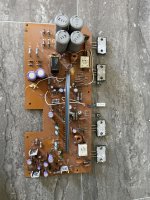 IMG_3337.jpeg613 KB · Views: 63
IMG_3337.jpeg613 KB · Views: 63 -
 IMG_3473.jpeg627.6 KB · Views: 56
IMG_3473.jpeg627.6 KB · Views: 56 -
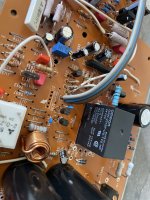 IMG_3477.jpeg487.8 KB · Views: 68
IMG_3477.jpeg487.8 KB · Views: 68 -
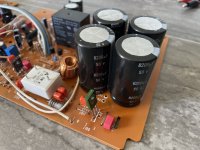 IMG_3478.jpeg401 KB · Views: 59
IMG_3478.jpeg401 KB · Views: 59 -
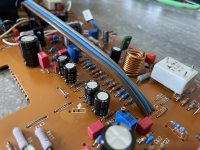 IMG_3482.jpeg400.9 KB · Views: 56
IMG_3482.jpeg400.9 KB · Views: 56 -
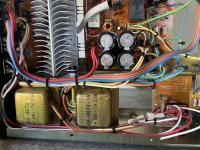 IMG_3497.jpeg587 KB · Views: 56
IMG_3497.jpeg587 KB · Views: 56 -
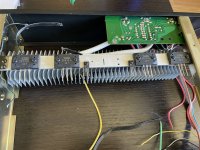 IMG_3489.jpeg581.7 KB · Views: 69
IMG_3489.jpeg581.7 KB · Views: 69 -
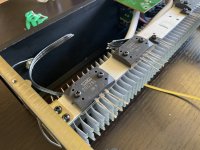 IMG_3487.jpeg450.4 KB · Views: 62
IMG_3487.jpeg450.4 KB · Views: 62 -
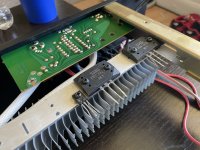 IMG_3488.jpeg458.2 KB · Views: 61
IMG_3488.jpeg458.2 KB · Views: 61 -
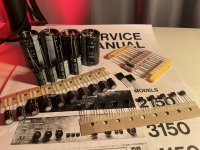 IMG_3461.jpeg498.5 KB · Views: 54
IMG_3461.jpeg498.5 KB · Views: 54 -
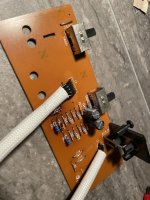 IMG_3464.jpeg444.3 KB · Views: 53
IMG_3464.jpeg444.3 KB · Views: 53
Last edited:
- Home
- Amplifiers
- Solid State
- Vintage NAD 3020 amplifier history and simulation in LTSpice with possible simple improvements
